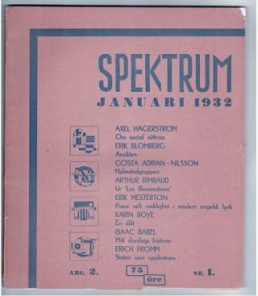Difference between revisions of "Spektrum"
| Line 1: | Line 1: | ||
[[Image:Spektrum_2-1_Jan_1932.jpg|thumb|258px|Cover of ''Spektrum'' 2:1 (January 1932).]] | [[Image:Spektrum_2-1_Jan_1932.jpg|thumb|258px|Cover of ''Spektrum'' 2:1 (January 1932).]] | ||
| − | '''Spektrum''' was an avant-garde magazine published in 1931-1933 in Stockholm. A driving force behind its foundation, that had been discussed among young left-wing intellectuals since 1929, was [[Josef Riwkin]], who, together with his family, had immigrated to Sweden from Russia in 1916. The other editors of the first number of the magazine that came out in the autumn of 1931 were the poet and novelist Karin Boye and the critic Erik Mesterton. Later editors included Gunnar Ekelöf, Sven Markelius, Pehr Henrik Törngren and Viola Wahlstedt. In 1932, the magazine introduced the work [[T. S. Eliot]] into Sweden. | + | '''Spektrum''' was an avant-garde magazine published in 1931-1933 in Stockholm. A driving force behind its foundation, that had been discussed among young left-wing intellectuals since 1929, was [[Josef Riwkin]], who, together with his family, had immigrated to Sweden from Russia in 1916. The other editors of the first number of the magazine that came out in the autumn of 1931 were the poet and novelist [[Karin Boye]] and the critic [[Erik Mesterton]]. Later editors included [[Gunnar Ekelöf]], [[Sven Markelius]], [[Pehr Henrik Törngren]] and [[Viola Wahlstedt]]. In 1932, the magazine introduced the work [[T. S. Eliot]] into Sweden. |
==Literature== | ==Literature== | ||
Revision as of 15:48, 25 December 2013
Spektrum was an avant-garde magazine published in 1931-1933 in Stockholm. A driving force behind its foundation, that had been discussed among young left-wing intellectuals since 1929, was Josef Riwkin, who, together with his family, had immigrated to Sweden from Russia in 1916. The other editors of the first number of the magazine that came out in the autumn of 1931 were the poet and novelist Karin Boye and the critic Erik Mesterton. Later editors included Gunnar Ekelöf, Sven Markelius, Pehr Henrik Törngren and Viola Wahlstedt. In 1932, the magazine introduced the work T. S. Eliot into Sweden.
Literature
- Claes-Göran Holmberg, Upprorets tradition. Den unglitterära tidskriften i Sverige, Stockholm: Symposion, 1987, 307 pp. (in Swedish) [1]
- Johan Svedjedal, Spektrum 1931–1935: Den svenska drömmen: Tidskrift och förlag i 1930-talets kultur, Stockholm: Wahlström & Widstrand, 2011. (in Swedish). Review, Review.
- Mats Jansson, "Crossing Borders: Modernism in Sweden and the Swedish-Speaking Part of Finland: Thalia (1909-13); Ny konst (1915); flamman (1917-21); Ultra (1922); Quosego (1928-9); kontakt (1931); Spektrum (1931-3); and Karavan (1934-5)", in The Oxford Critical and Cultural History of Modernist Magazines, Vol. 3 (Europe, 1880-1940), New York: Oxford University Press, 2013, pp 666-690. [2]
External links
- Scans of a selection of writings and translations by Gunnar Ekelöf in Spektrum, 1931-32.
- Spektrum at National Library of Sweden
| Avant-garde and modernist magazines | ||
|---|---|---|
|
Poesia (1905-09, 1920), Der Sturm (1910-32), Blast (1914-15), The Egoist (1914-19), The Little Review (1914-29), 291 (1915-16), MA (1916-25), De Stijl (1917-20, 1921-32), Dada (1917-21), Noi (1917-25), 391 (1917-24), Zenit (1921-26), Broom (1921-24), Veshch/Gegenstand/Objet (1922), Die Form (1922, 1925-35), Contimporanul (1922-32), Secession (1922-24), Klaxon (1922-23), Merz (1923-32), LEF (1923-25), G (1923-26), Irradiador (1923), Sovremennaya architektura (1926-30), Novyi LEF (1927-29), ReD (1927-31), Close Up (1927-33), transition (1927-38). | ||
| Full list | ||
|---|---|---|
|
Entretiens politiques et littéraires (1890-93), Moderní revue (1894-1925), Volné směry (1897-1948), Mir iskusstva (1898-1904), Vesy (1904-09), Poesia (1905-09, 1920), Zolotoe runo (1906-10), The Mask (1908-29), Apollon (1909-17), Ukraïnska khata (1909-14), Der Sturm (1910-32), Thalia (1910-13), Rhythm (1911-13), Trudy i dni (1912), Simbolul (1912), The Glebe (1913-14), Ocharovannyi strannik (1913-16), Revolution (1913), Blast (1914-15), The Little Review (1914-29), Futuristy (1914), Zeit-Echo (1914-17), The Egoist (1914-19), L'Élan (1915-16), 291 (1915-16), Orpheu (1915), La Balza futurista (1915), MA (1916-25), SIC (1916-19), flamman (1916-21), The Blindman (1917), Nord-Sud (1917-18), De Stijl (1917-20, 1921-32), Dada (1917-21), Klingen (1917-20, 1942), Noi (1917-25), 391 (1917-24), Modernisme et compréhension (1917), Anarkhiia (1917-18), Iskusstvo kommuny (1918-19), Formiści (1919-21), S4N (1919-25), La Cité (1919-35), Aujourd'hui (1919), Exlex (1919-20), L'Esprit nouveau (1920-25), Orfeus (1920-21), Action (1920-22), Proverbe (1920-22), Ça ira (1920-23), Zenit (1921-26), Kinofon (1921-22), Het Overzicht (1921-25), Jednodńuwka futurystuw (1921), Nowa sztuka (1921-22), Broom (1921-24), Život (1921-48), Creación (1921-24), Jar-Ptitza (1921-26), New York Dada (1921), Aventure (1921-22), Spolokhi (1921-23), Gargoyle (1921-22), Veshch/Gegenstand/Objet (1922), Kino-fot (1922-23), Le Coeur à barbe (1922), Die Form (1922, 1925-35), 7 Arts (1922-28), Manomètre (1922-28), Ultra (1922), Út (1922-25), Dada-Jok (1922), Dada Tank (1922), Dada Jazz (1922), Mécano (1922-23), Contimporanul (1922-32), Zwrotnica (1922-23, 1926-27), Secession (1922-24), Stavba (1922-38), Gostinitsa dlya puteshestvuyuschih v prekrasnom (1922-24), Putevi (1922-24), Klaxon (1922-23), Akasztott Ember (1922-23), MSS (1922-23), Perevoz Dada (1922-49), Egység (1922-24), L'Architecture vivante (1923-33), Merz (1923-32), LEF (1923-25), G (1923-26), The Next Call (1923-26), Russkoye iskusstvo (1923), Disk (1923-25), Irradiador (1923), Surréalisme (1924), Almanach Nowej Sztuki (1924-25), La Révolution surréaliste (1924-29), Blok (1924-26), Pásmo (1924-26), DAV (1924-37), Bulletin de l'Effort moderne (1924-27), ABC (1924-28), CAP (1924-28), Athena (1924-25), Punct (1924-25), 75HP (1924), Le Tour de Babel (1925), Periszkop (1925-26), Integral (1925-28), Praesens (1926, 1930), Sovremennaya architektura (1926-30), bauhaus (1926-31), Das neue Frankfurt (1926-31), L'Art cinématographique (1926-31), Dokumentum (1926-27), Kritisk Revy (1926-28), Novyi LEF (1927-29), i 10 (1927-29), Nova generatsiia (1927-30), ReD (1927-31), Dźwignia (1927-28), Tank (1927-28), Close Up (1927-33), Horizont (1927-32), transition (1927-38), Discontinuité (1928), Munka (1928-39), Quosego (1928-29), Urmuz (1928), Unu (1928-32), Revista de Antropofagia (1928-29), 50 u Evropi (1928-29), Documents (1929-30), L'Art Contemporain - Sztuka Współczesna (1929-30), Adam (1929-40), Art concret (1930), Zvěrokruh (1930), Alge (1930-31), Le Surréalisme au service de la révolution (1930-33), Levá fronta (1930-33), Kvart (1930-37, 1945-49), Nová Bratislava (1931-32), Linja (1931-33), Spektrum (1931-33), Nadrealizam danas i ovde (1931-32), Ulise (1932-33), Die neue Stadt (1932-33), Mouvement (1933), PLAN (1933-36), Karavan (1934-35), Ekran (1934), Axis (1935-37), Acéphale (1936-39), Telehor (1936), aka (1937-38), Plastique (1937-39), Plus (1938-39), Les Réverbères (1938-39). | ||
